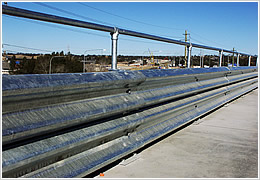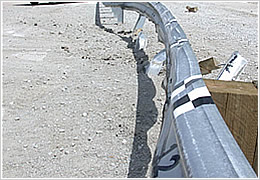dezhou dafa guardrail barrier factory. E-mail:sales@guardrailbarrier.com
Products Show
- Thrie Beam Guardrails
- W Beam Guard Rails
- Steep Slope Guardrail
- Guardrail Barrier
- Guard Rail
- Highway Guardrail
- Guardrail System
- Guardrail Definition
- Temporary Guard Rails
- Highway Safety Products
- Guardrail Design
- Guardrail Requirements
- Guardrail Fence
- Guard Railing
- Safety Guard Rail
- Galvanized Guard Rails
- Metal Guard Rails
- Steel Guardrail Systems
Guardrail Design
Energy Absorbing Guardrail Terminal Platform Grading
1. The purpose of the guardrail terminal platform is to reproduce to the extent practical the
physical conditions under which the terminal unit was tested for its NCHRP 350 test level
certification.
2. The grading of the platform (from the platform’s edge perpendicular to the roadway) must
not be any steeper than a 4:1 slope even if it requires grading down to the toe of the slope.
This is to minimize the possibility of inducing lateral (side
to side) instability to an errant vehicle.
3. The algebraic difference of the approach grade (from the platform’s edge parallel to the
roadway slopes) compared to either the platform’s grade or the slope the approach grade
ties into, must not exceed 10%. This is to minimize the possibility of inducing longitudinal
(front to back) instability to the errant vehicle.
4. The above criteria are to allow the vehicle to remain stable if it leaves the pavement. It is
essential that the approach grading for the platform blend smoothly from its edge to the
roadway slope. In no circumstance should the design of the platform be compromised
such that the platform itself could induce instability to the errant vehicle.
5. The “minimum acceptable design” for guardrail platforms without actually constructing a
platform is to provide smooth grading with 4:1 or flatter slopes perpendicular to the
roadway approaching, adjacent to, and behind the terminal for its entire length.
6. The “preferred design” should be used whenever possible and is required on roadways such
as Interstates. For other types of roadways, if the preferred design cannot be
accommodated due to right-of-way, environmental, or other constraints, then the
“alternative design” should be used. If the constraints are still such that the “alternative
design” cannot be accommodated, then the “minimum acceptable design” must be
provided. The “minimum acceptable design” is only appropriate if the other platform
designs cannot be provided.




